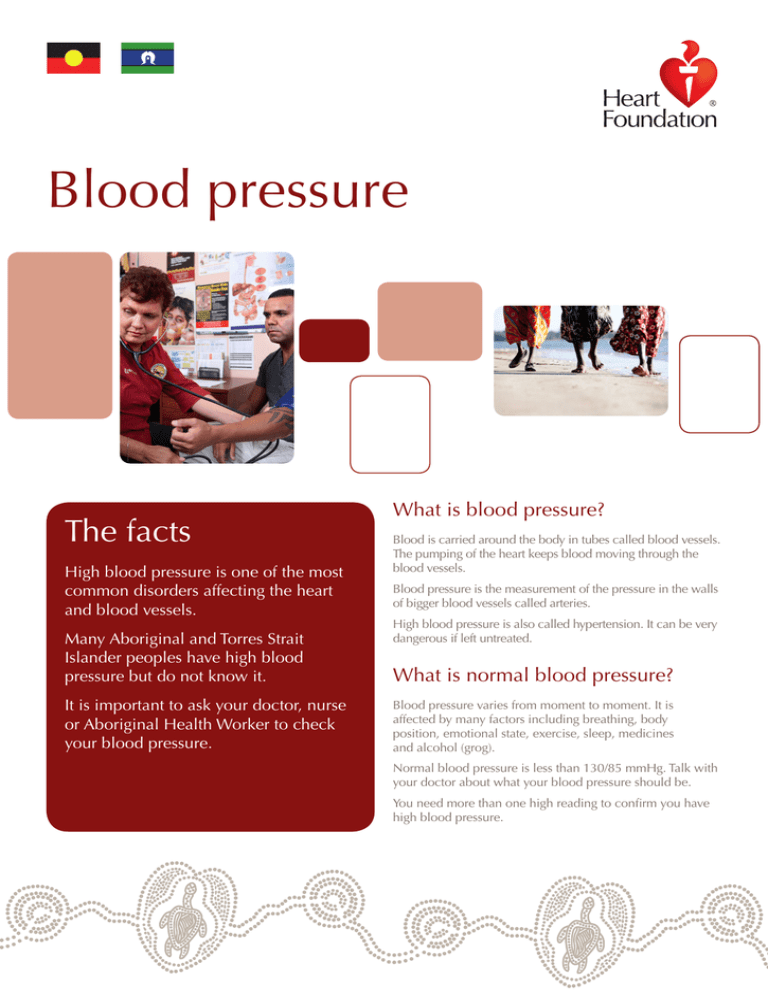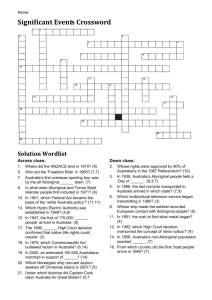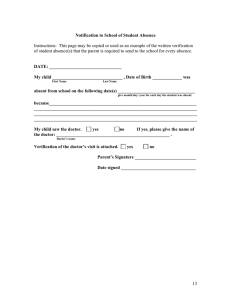Blood pressure - The Heart Foundation
advertisement

Blood pressure The facts High blood pressure is one of the most common disorders affecting the heart and blood vessels. Many Aboriginal and Torres Strait Islander peoples have high blood pressure but do not know it. It is important to ask your doctor, nurse or Aboriginal Health Worker to check your blood pressure. What is blood pressure? Blood is carried around the body in tubes called blood vessels. The pumping of the heart keeps blood moving through the blood vessels. Blood pressure is the measurement of the pressure in the walls of bigger blood vessels called arteries. High blood pressure is also called hypertension. It can be very dangerous if left untreated. What is normal blood pressure? Blood pressure varies from moment to moment. It is affected by many factors including breathing, body position, emotional state, exercise, sleep, medicines and alcohol (grog). Normal blood pressure is less than 130/85 mmHg. Talk with your doctor about what your blood pressure should be. You need more than one high reading to confirm you have high blood pressure. What causes high blood pressure? • F amily history •B eing overweight •P oor diet • Too much salt •D rinking too much alcohol (grog) •N ot exercising •C igarette smoking •K idney problems What are the risks of high blood pressure? •H eart disease How to help prevent or manage high blood pressure • Stop smoking • Eat healthy foods • Reduce your salt intake • Drink less alcohol (grog) • Maintain a healthy weight • Increase physical activity – aim for 30 minutes or more of moderate intensity physical activity every day of the week •H ave your blood pressure checked regularly • Take your medications as directed by your doctor Visit your health worker, Aboriginal Medical Service or doctor and get your blood pressure checked today. • Heart failure • S troke •K idney disease or failure • E ye problems © 2016 National Heart Foundation of Australia ABN 98 008 419 761 First published 2013; Reprinted with corrections 2016 Terms of use: This material has been developed for general information and educational purposes only. It does not constitute medical advice. Please consult your healthcare provider if you have, or suspect you have, a health problem. The health information provided has been developed by the Heart Foundation and is based on independent research and the available scientific evidence at the time of writing. The information is obtained and developed from a variety of sources including, but not limited to, collaborations with third parties and information provided by third parties under licence. It is not an endorsement of any organisation, product or service. While care has been taken in preparing the content of this material, the National Heart Foundation of Australia, its employees and related parties cannot accept any liability, including for any loss or damage, resulting from the reliance on the content, or for its accuracy, currency and completeness. This material may be found in third parties’ programs or materials (including, but not limited to, show bags or advertising kits). This does not imply an endorsement or recommendation by the National Heart Foundation of Australia for such third parties’ organisations, products or services, including their materials or information. Any use of National Heart Foundation of Australia materials or information by another person or organisation is at the user’s own risk. The entire contents of this material are subject to copyright protection. Enquiries concerning permissions should be directed to copyright@heartfoundation.org.au INF-082-C.v2



